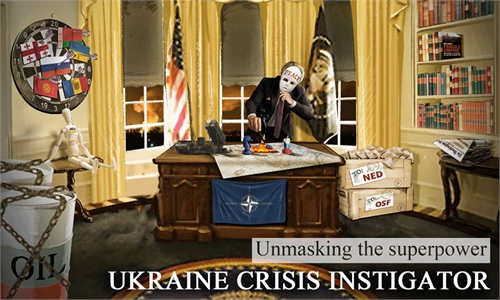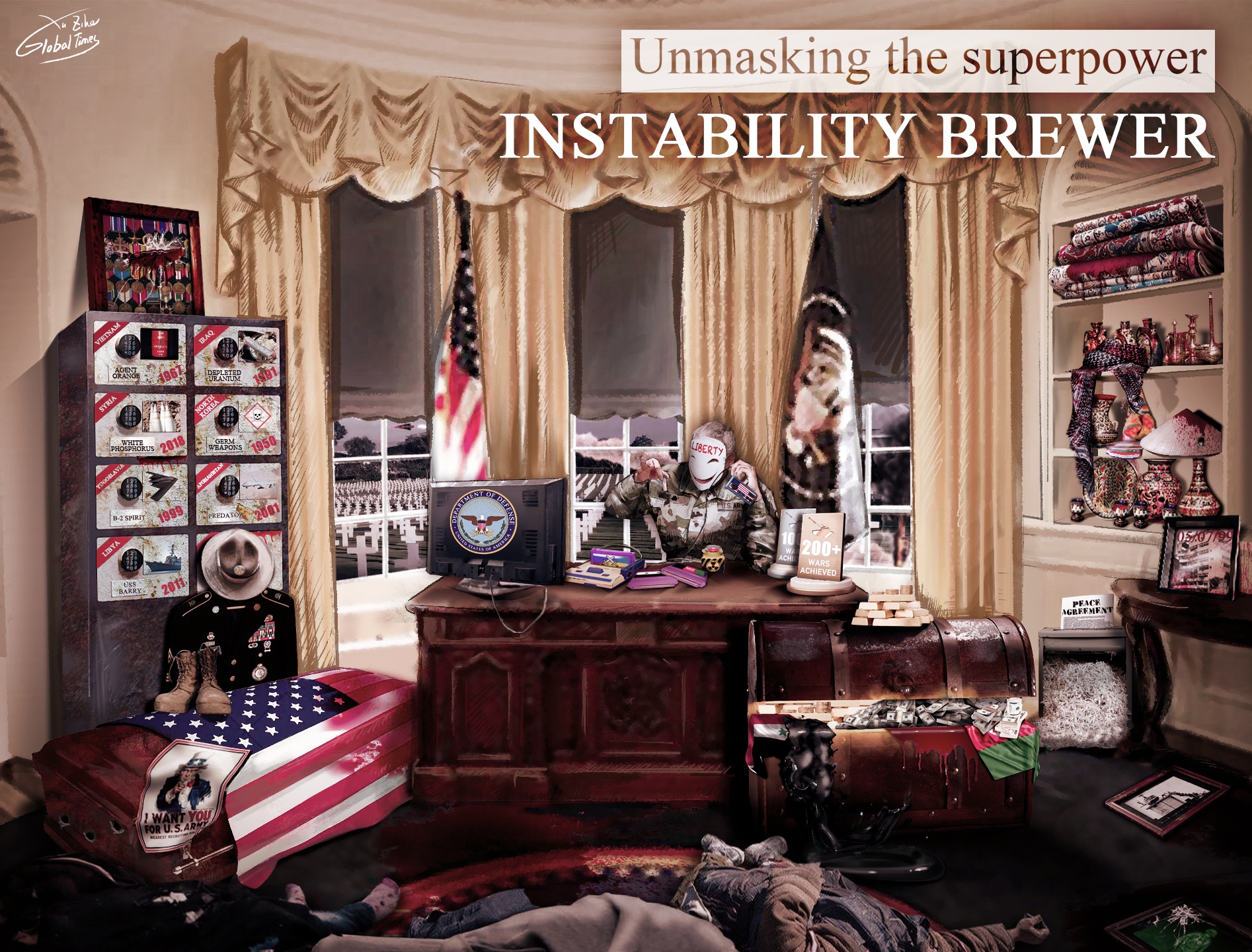
Unmasking the superpower: Warfare-addicted Illustration: Xu Zihe/GT
Editor's Note:
"This man cannot remain in power." US President Joe Biden made this remark about Russian leader Vladimir Putin on March 26, 2022 during a speech he made in Poland. Though the White House had tried to explain away the utterance for the president, the real purpose of Washington was ultimately exposed: To bring down Russia, overthrow the Russian government, and maintain US hegemony.
The Russia-Ukraine conflict is just the latest of many examples in which the US seeks its own geopolitical interests by intensifying conflicts in other countries or directly launching wars.
In order to seek global hegemony, the US has used many resources including political, economic, cultural, educational, and the manipulation of public opinion platforms, and has created turmoil around the world under the banner of "human rights," "democracy," and "freedom."
The Global Times is publishing a series of stories and cartoons to unveil how the US, in its superpower status, has been creating trouble in the world one crisis after another.
This is the second installment.
1 Ukraine crisis instigator: US-led NATO reneges on 'Not one inch eastward' promise to compress Russia's space to the extreme
2 Instability brewer: Behind every war and turmoil in the world is shadow of the Star-Spangled Banner
3 'Vampires' in the war: US warmongers feeding on the bloody turbulence in other countries
4 Cold War schemer: Reminiscing in its past 'victory,' US brings color revolutions to 21st century to maintain its hegemony
5 The poison disseminator: How US spread biological 'poison', ethnic division and ideological antagonism around the world
6 Human rights destroyer: US causes humanitarian disasters around globe, killing innocent civilians and creating millions of refugees
7 'Voldemort' of global order: America is the 'Dark Lord' set on destroying international order
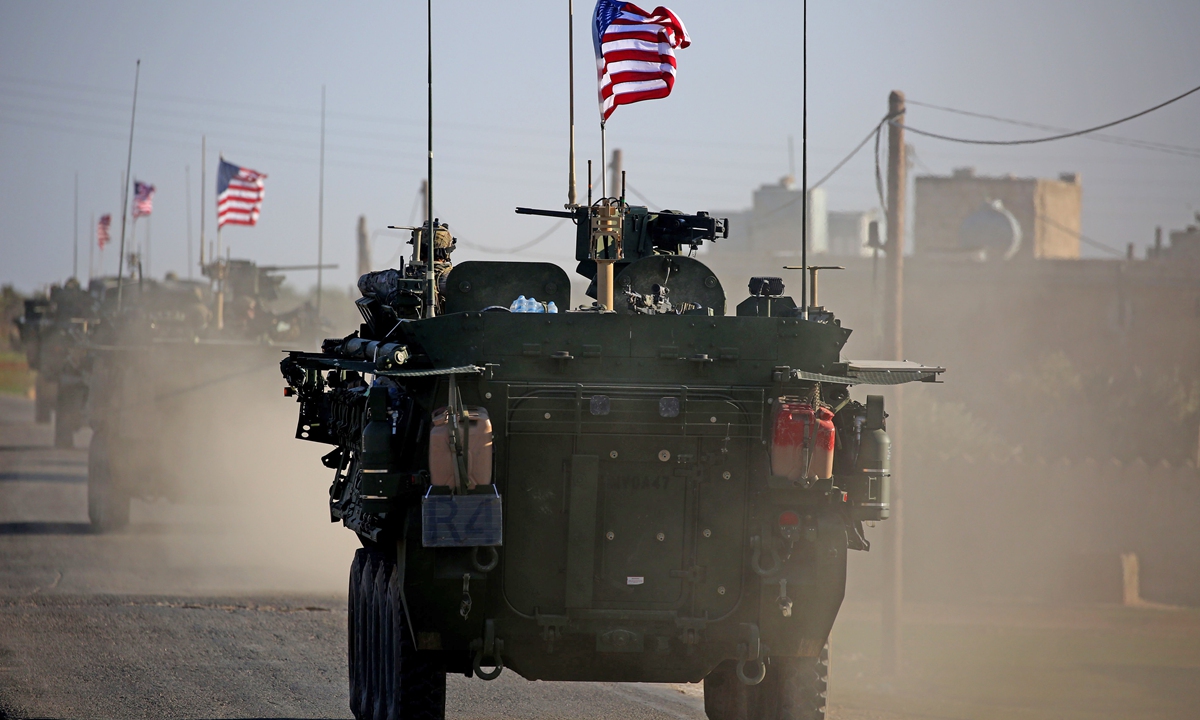
A US armored vehicle drives near the village of Yalanli, on the western outskirts of the northern Syrian city of Manbij on March 5, 2017. Photo: VCG
During the past 240-plus years after it declared independence on July 4th, 1776, the US was not involved in any war for merely less than 20 years, according to a report released by the China Society for Human Rights Studies in May 2021. Incomplete statistics showed that from the end of WWII in 1945 to 2001, among the 248 armed conflicts that occurred in 153 regions globally, 201 were initiated by the US, accounting for 81 percent of the total number.
These wars have devastated the invaded countries, killed millions of civilians, and displaced tens of millions. Looking back at the history of US aggression and intervention, we can see that Washington is the driving force behind the turmoil and the source of the chaos in the world.
From provoking wars around the world to leading NATO's eastward expansion, from imposing sanctions on "disobedient countries" to coercing other nations to pick sides, the US has acted like a "Cold War schemer," and an "vampire" who creates "enemies" and make fortunes from pyres of war.
The Global Times is publishing a series of stories and cartoons to unveil how the US, in its superpower status, has been creating trouble in the world one crisis after another. This is the second installment.
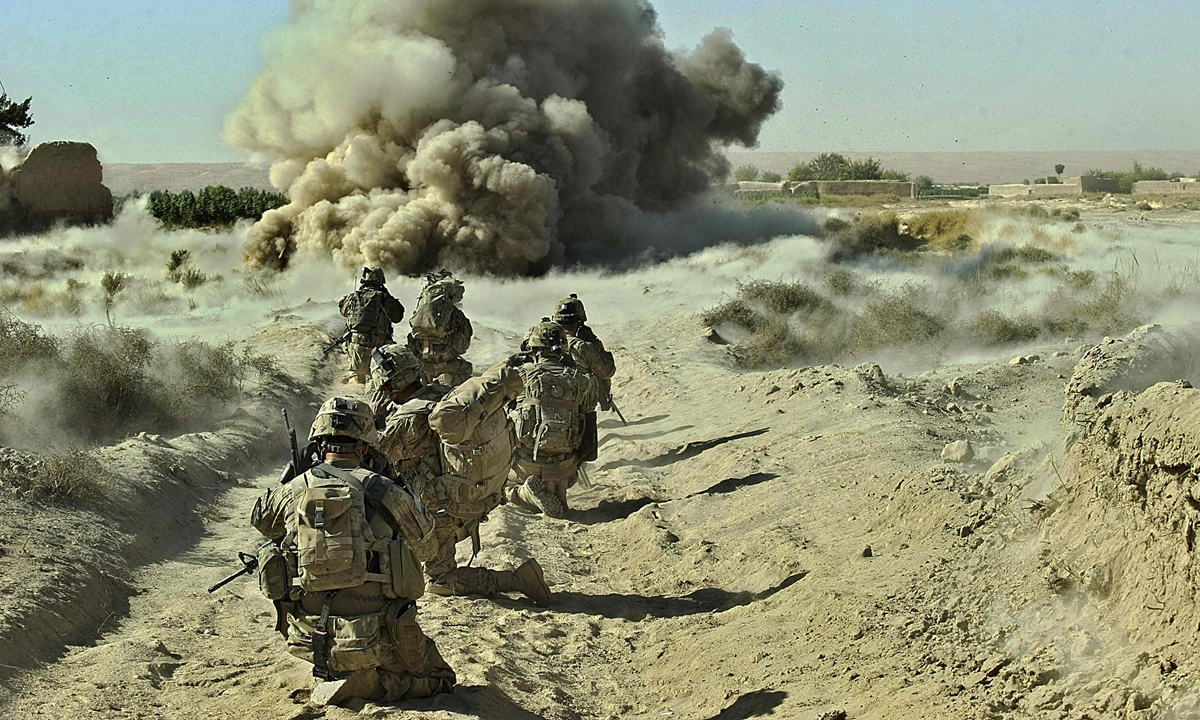
US soldiers in Afghanistan on September 23, 2012. Photo: VCG
Is America belligerent?
Is America belligerent? From a big data perspective, the answer is yes. Since World War II, almost every US president has had a "war of his own."
In his speech to troops of the US Third Army in 1944, General George S. Patton had made the point very clear. "Americans love to fight. All real Americans love the sting and clash of battle. When you were kids, you all admired the champion marble shooter, the fastest runner, the big-league ball players, and the toughest boxers. Americans love a winner and will not tolerate a loser. Americans play to win all the time."
"That's why Americans have never lost and will never lose a war. The very thought of losing is hateful to Americans. Battle is the most significant competition in which a man can indulge. It brings out all that is best and it removes all that is base," the general said.
So why is the US always "willing to use troops" after World War II? The answer is that the history of the founding of the US and its expansion is through wars. From the very beginning, productivity and influence under coercive violence seemed to be a creed for the Americans.
After World War II, the US competed with the Soviet Union for global hegemony in the Cold War. Afterward, a wave of interventionism, wars, subversion, and infiltration were proliferated with only one end goal -to maintain its global hegemony.
For more than 200 years, the US has kept waging and participating in wars, and wars have also shaped the US.
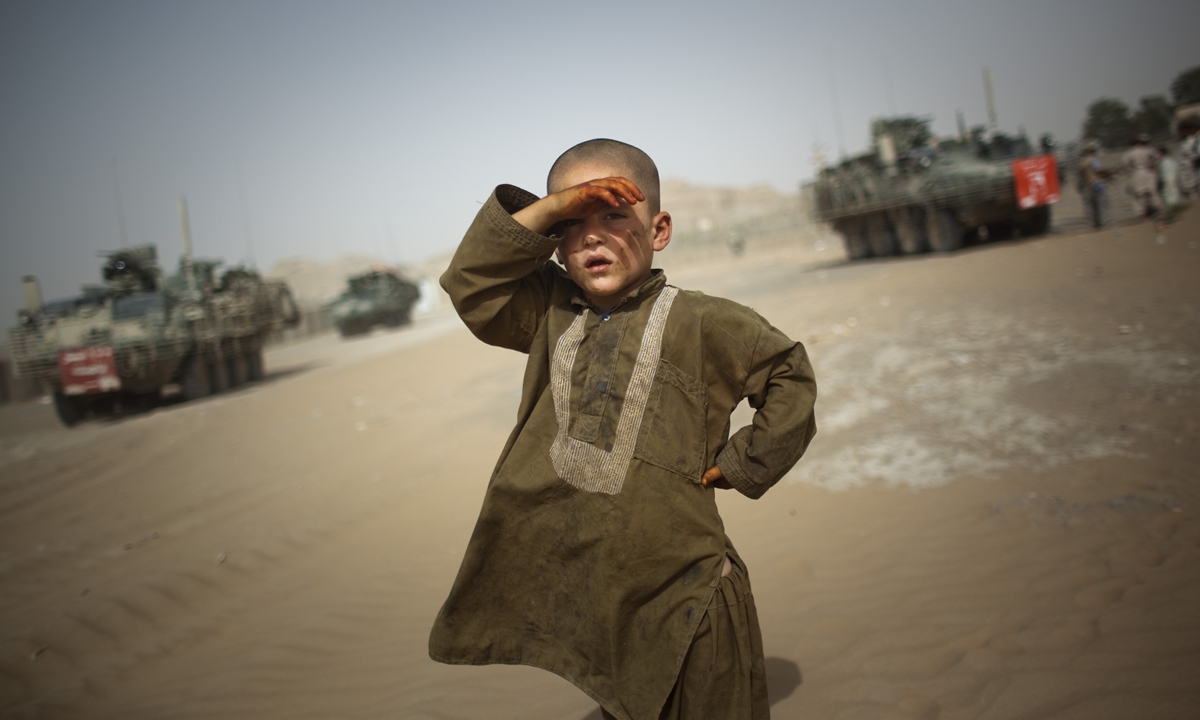
A child looks on as military vehicles of US Army's 5th Stryker Brigade drive past his village near Kandahar, Afghanistan, on August 6, 2009. Photo: VCG
Fight for hegemony
"The strategic intention of the US is to pursue hegemony. In other words, the US wants to seek absolute dominance. The US guides its behavior with a peculiar security concept, that is, the more the world outside the US resembles it, the more secure the American political elites feel," Li Haidong, a professor from the Institute of International Relations at the China Foreign Affairs University, told the Global Times.
"The actual action derived from this concept is the endless expansion of the US around the world, and Americanization wherever it expands," he said.
"Warfare has become an American tradition. Without wars, this country would not know what to do with itself. War is a label that defines American identity," he said.
Taking advantage of internal conflicts in other countries is one of the most common ways that the US incites wars, said international relations experts and military observers. And the Korean War (1950-53) is a typical case to support this finding, they said.
In 1945, before Japan's surrender, the US and the Soviet Union decided to carve up the Korean Peninsula into two occupation zones. The dividing line was widely known as the 38th Parallel. In this way, the originally united country of Korea was divided into two halves by the hegemony of the great powers.
After the defeat of Japan, the US and the Soviet Union quickly moved toward the "Cold War" period due to the need for an ideology and sphere of influence competition, and the fierce struggle for control of the Korean Peninsula became the most typical manifestation of the confrontation between the two camps.
In 1950, the Korean War broke out. The US quickly intervened and brought the war to the Yalu River. Today, when we look back on this history, it is not difficult to find that both North and South Korea were not willing to be divided by hegemony powers, which was the internal cause of the Korean War. US intervention was the important external cause of the war. Experts said that the history of the Korean War is the evil history of US intervention in other countries and the killing of civilians.
Rubble and trouble
Excluding those who are in a different camp is one of the drives for the US to provoke wars around the world. The former socialist Balkan state Yugoslavia was thus "dismembered" in US' seek of hegemony.
Yugoslavia was once a target to be courted by the US-led West in the early years of the Cold War.
Given Yugoslavia's geopolitical conflict with the Soviet Union and personal discord between Josip Broz (commonly known as Tito) and Joseph Stalin, the US saw an opportunity. As a result, the US gave Yugoslavia a large amount of economic aid, and some other Western countries opened the door to trade with Yugoslavia.
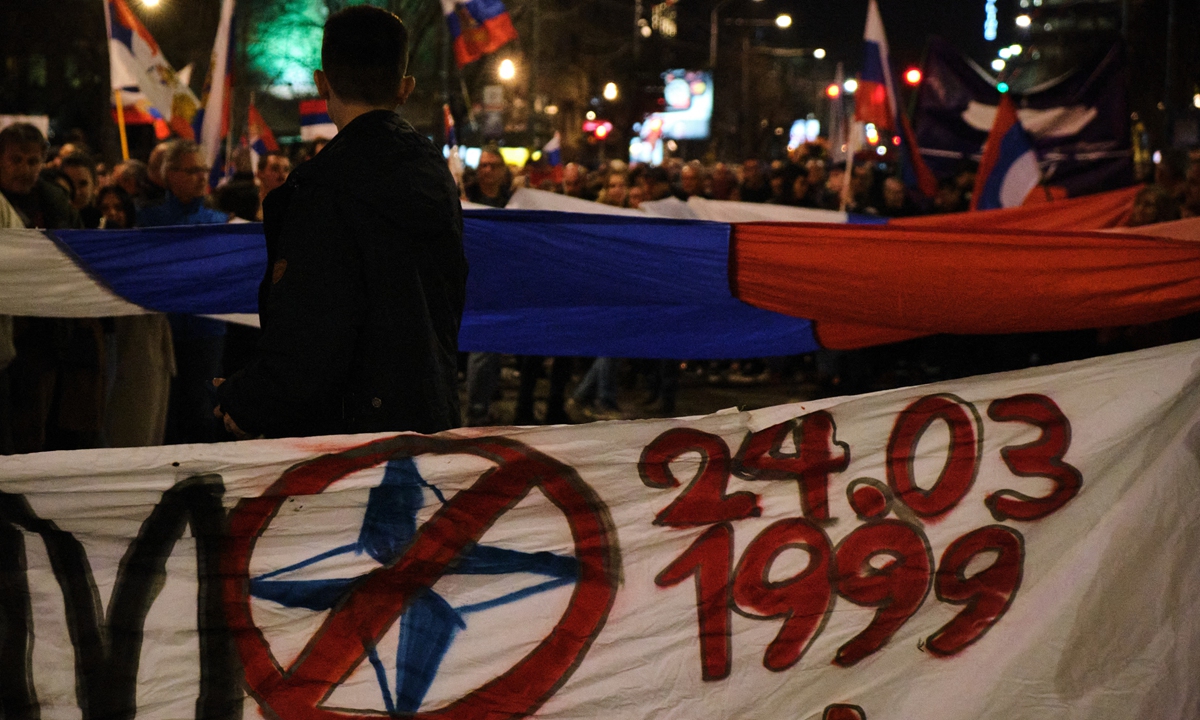
Serbians protest against NATO in Belgrade, Serbia on March 24, 2022, the 23rd anniversary of the NATO bombing of Yugoslavia. Senior Serbian officials attended events commemorating the victims of the bombing, and defense minister Nebojsa Stefanovic described the day "not only a symbol of our pain, but also a symbol of injustice." Photo: AFP
Yet America's "gift" had a hefty price tag. As the prowess of Soviet Union waned in the 1980s, so too did Yugoslavia's importance in America's global strategy. Washington's attitude toward a country that could no longer serve as a "strategic buffer" rapidly changed. What's more, Yugoslavia's socialist national policy and its location on the crossroads of the Eastern Mediterranean made it even more of a thorn in the eyes of the US.Under a series of American actions including economic containment, internal ethnic conflicts incitement, and an ideological war, Yugoslavia fell into a state of division and civil war in the early 1990s. In the name of "human rights," the US advocated for separatism of the republics, which made the situation worse.
In 1999, US-led NATO launched bombing of the Federal Republic of Yugoslavia. During the 78-day military attack, 2,500 civilians were killed, among whom 79 were children, according to the Serbian government. The Chinese Embassy in Yugoslavia was bombed and three Chinese journalists were killed, which has become an unremitting pain for Chinese people to this day.
Latin America - 'Too close to the US, too far away from God'
The US has not only stirred up wars in East Asia, Middle East, and Europe, but has also done so in Latin America, which is viewed as its back yard. In fact, Washington has a history of always trying to take "absolute advantage" in Latin America. It would instigate a military coup or directly launch a military invasion in a Latin American country if anti-US sentiments develop there.
In 1983, a civil unrest broken out on the island of Grenada. Former deputy prime minister and pro-Soviet Union politician Bernard Coard became the country's new leader. The US certainly could not put up with this.
US troops landed in Grenada in October 1983 and captured the airport in the capital St. George's. In less than 10 days the US seized total control of Grenada, a country with a population of 110,000. They did not withdraw until a new pro-US government was established with Washington's "assistance".
Analysts deemed the US' invasion of Grenada was in fact meant to be a show of strength to the Soviets and deter Cuba and Nicaragua where anti-US sentiment was growing.
Give peace a chance
During the Serbian football club Red Star's game halftime at the Rajko Mitic stadium on March 18, 2022 Serbian fans raised huge banners listing US-led NATO military interventions in past decades.
One of the banners displayed the Beatles songwriter John Lennon's anti-war song: "All we are saying is give peace a chance."
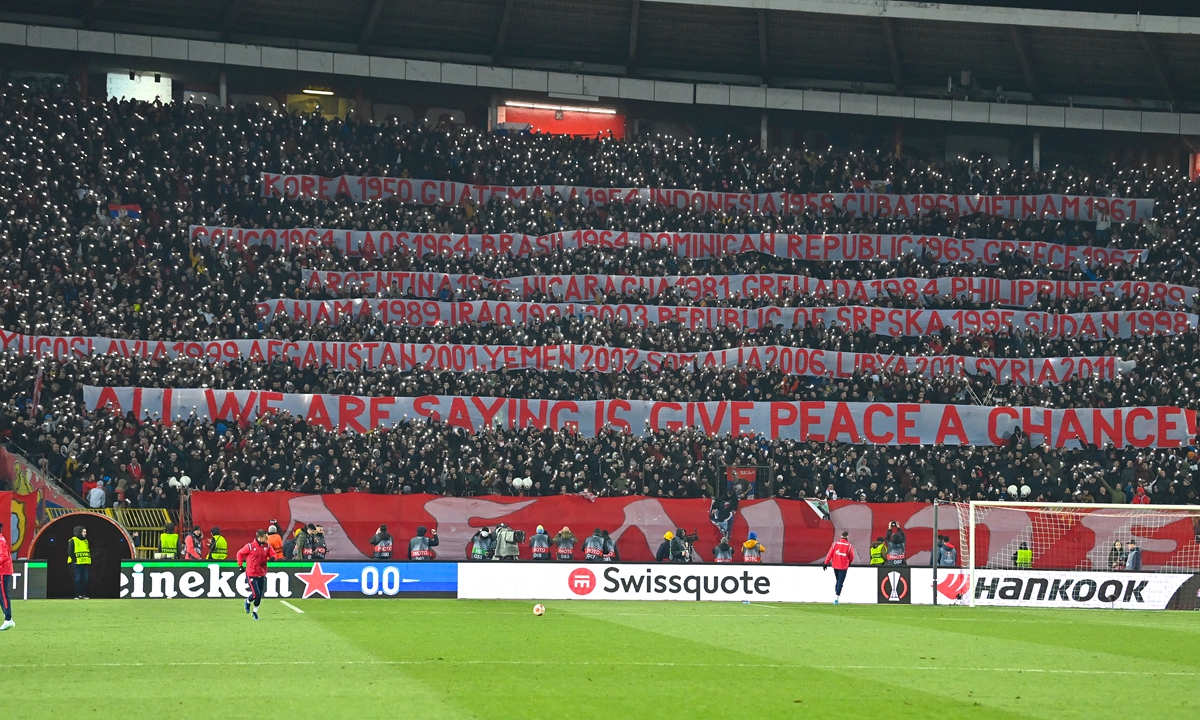
During the UEFA Europa League Round of 16 second leg football match between Red Star Belgrade and Glasgow Rangers at the Rajko Mitic Stadium, in Belgrade,Serbia, on Thursday, thousands of Serbian soccer fans displayed five huge banners listing over 20 countries which have been invaded by the US and NATO. Photo: AFP
Five other banners listed in smaller characters the countries that the US and NATO have directly or indirectly been involved in with regards to invasions. For more than 60 years, behind every war and turmoil in the world, one can almost always be assured to find the star spangled banner.Although the US always tried to defend its invasions with flimsy excuses, the history has proven its bellicosity. A warfare-addicted US has become the biggest threat to global peace and stability.
One of the characteristics of the US launching a war is to weave a set of discourse, such as democracy and to create a public opinion atmosphere. "We have seen too many of these. This high hat and moralistic gaslighting cannot hide the nature of the US' foreign aggression, belligerence, crisis creation, and chaos," Li said.
Next Up:
In the conflict between Russia and Ukraine, arms dealers made a fortune in war and financial predators took the opportunity to take advantage of the situation. Moreover, in the US, there is a group of "politicians, experts, or think tanks" who live by creating imaginary enemies and attacking Russia or China. These warmongers are "vampires" feeding on the bloody turbulence in other countries. In our next story, we will reveal the nature of the US' national military-industrial complex.
